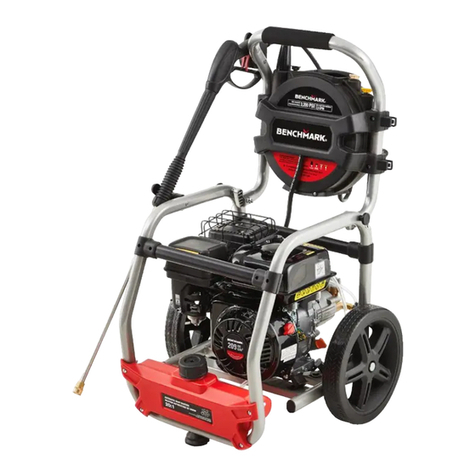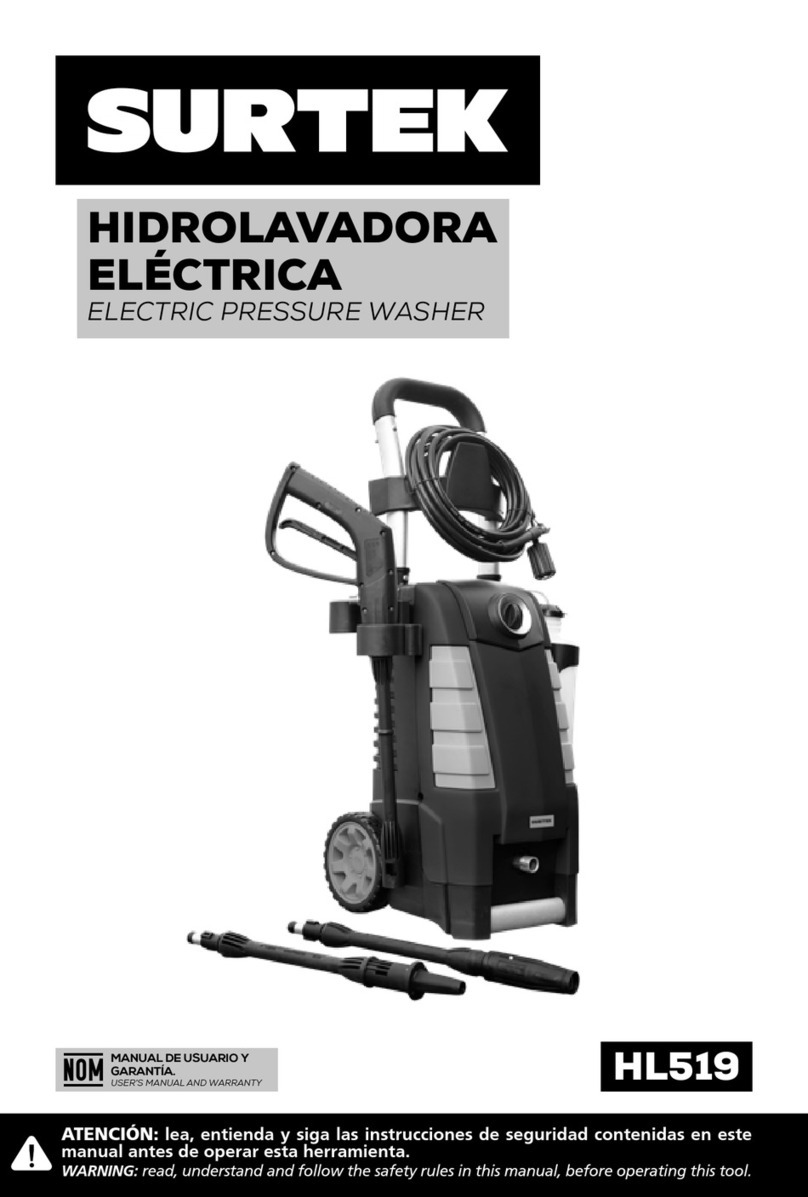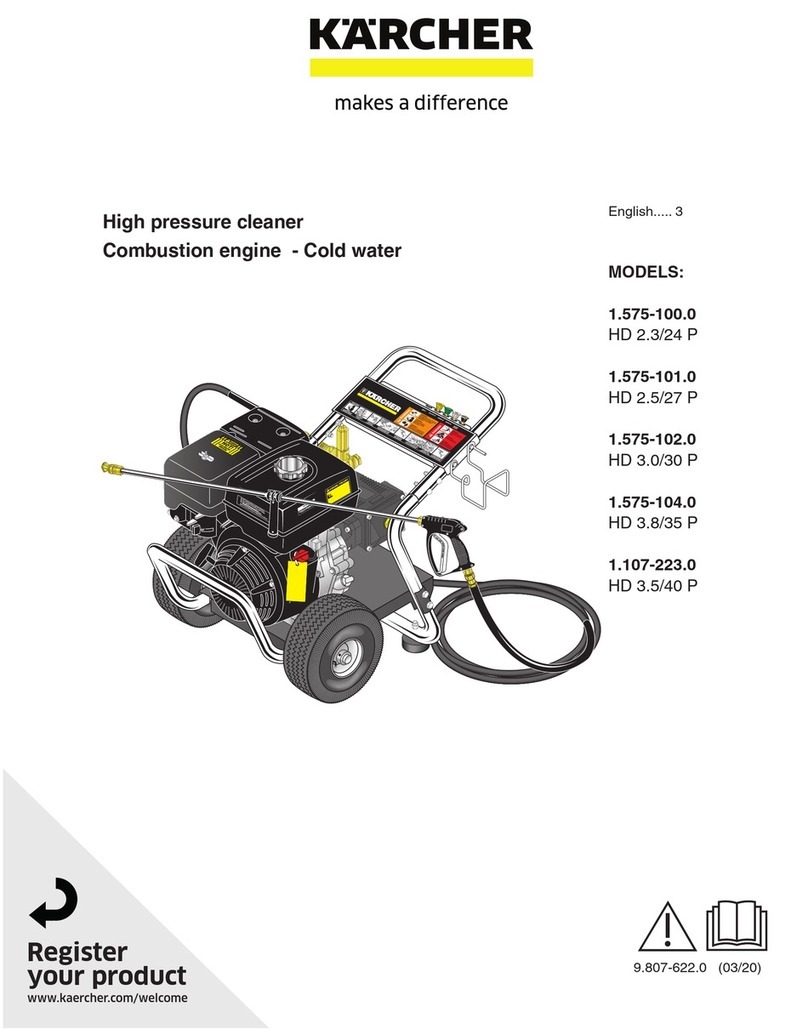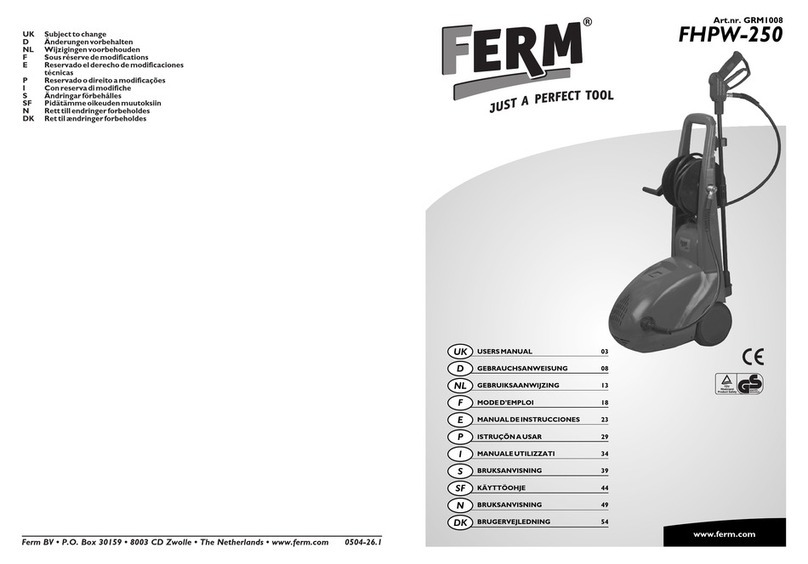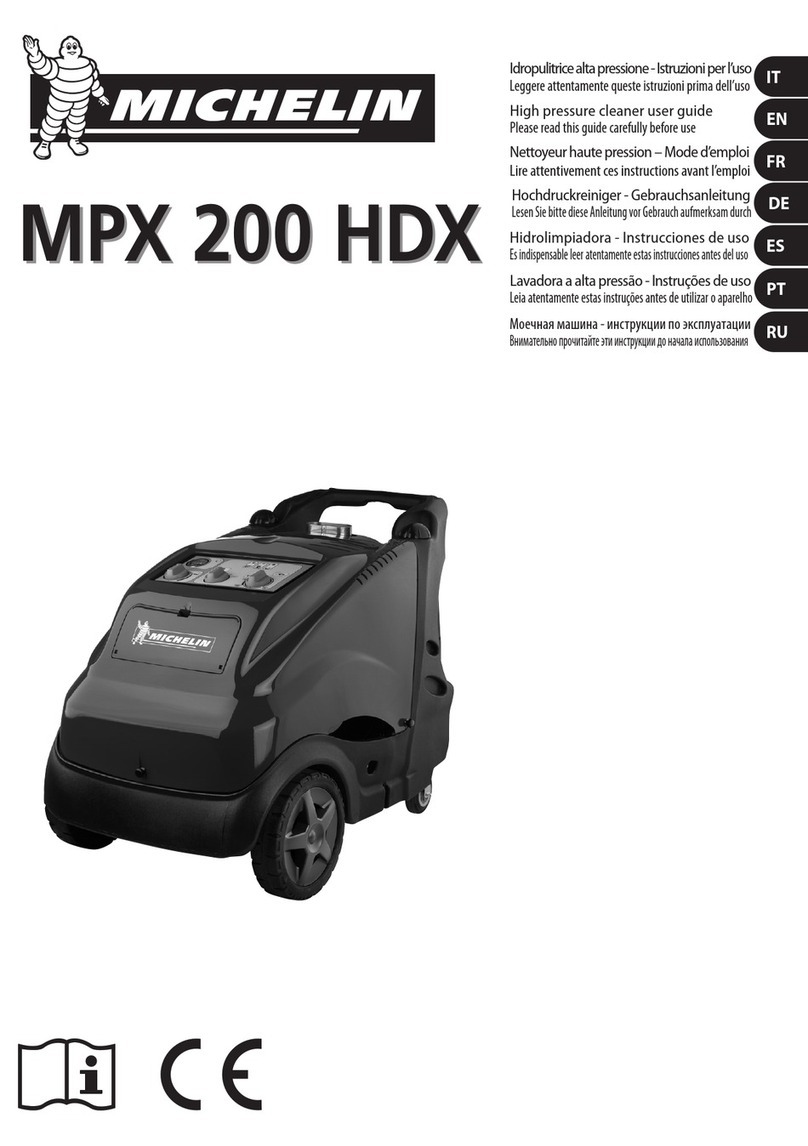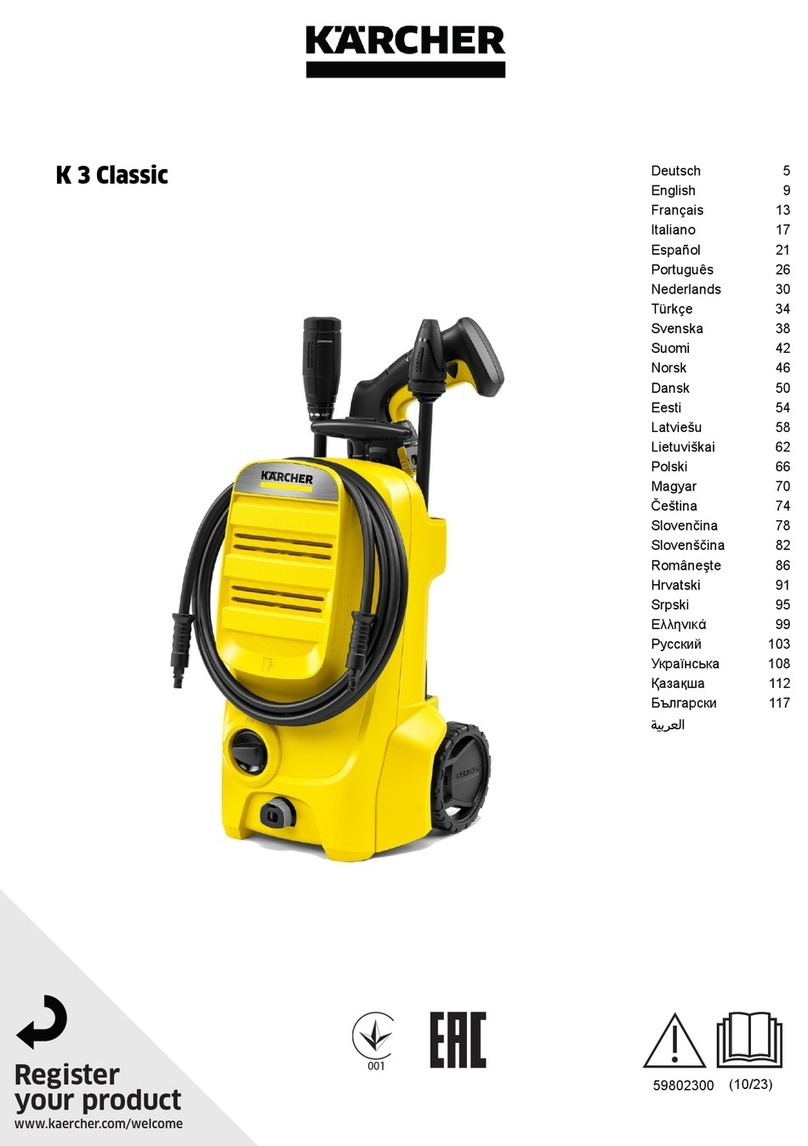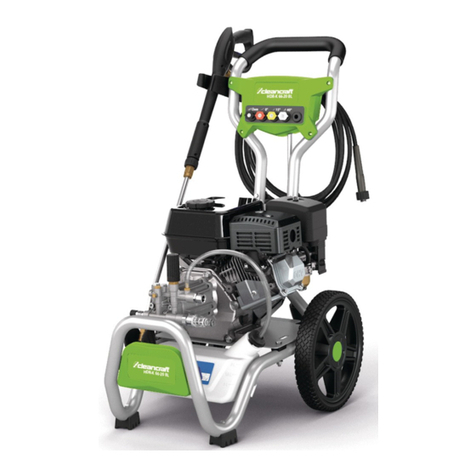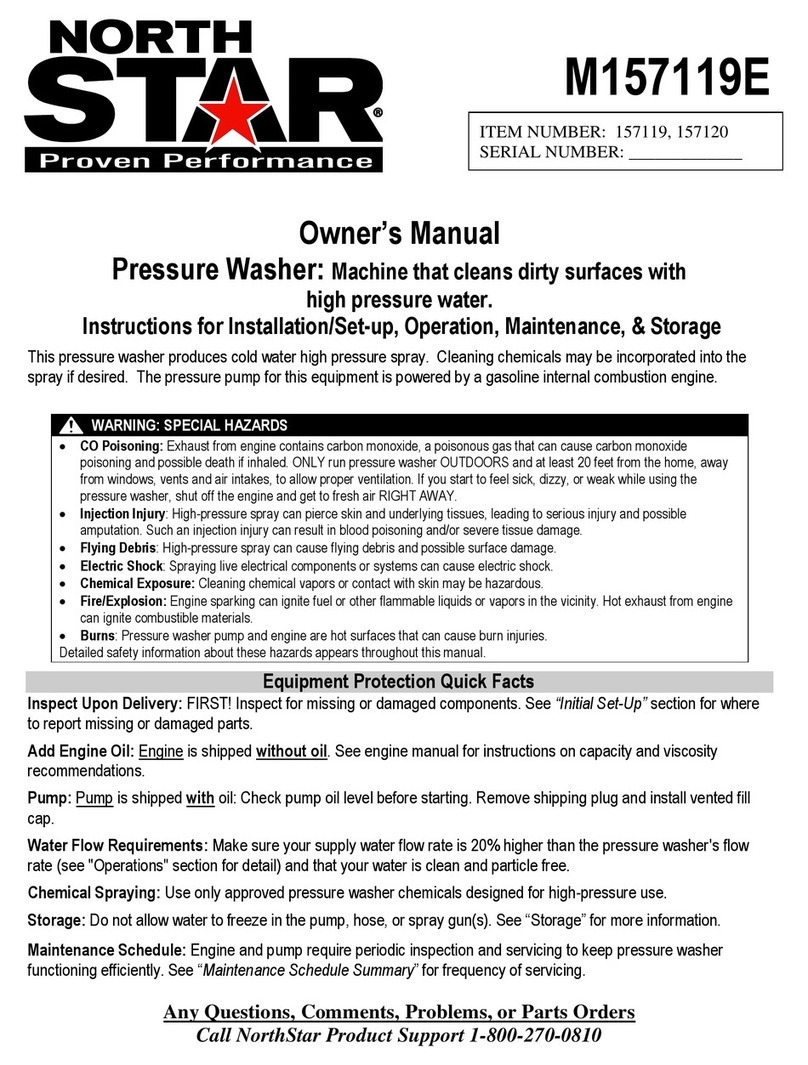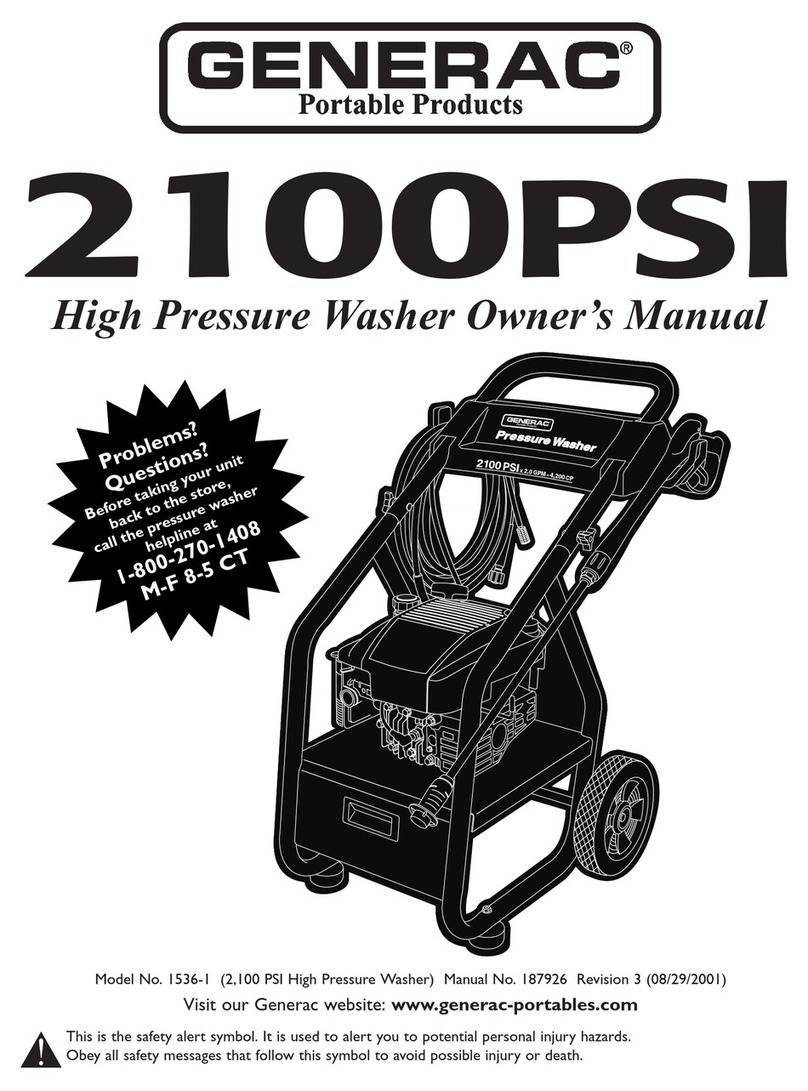Brave MBR2528HCOA.1 User manual

MBR2528HCOA.1
Owner’s Manual
Pressure Washer: Machine that cleans dirty surfaces with
high pressure water.
Instructions for Installation/Set-up, Operation, Maintenance, & Storage
This pressure washer produces cold water high pressure spray. Cleaning chemicals may be incorporated into the
spray if desired. The pressure pump for this equipment is powered by a gasoline internal combustion engine.
WARNING: SPECIAL HAZARDS
CO Poisoning: Exhaust from engine contains carbon monoxide, a poisonous gas that can cause carbon monoxide
poisoning and possible death if inhaled. ONLY run pressure washer OUTDOORS and at least 20 feet from the home, away
from windows, vents and air intakes, to allow proper ventilation. If you start to feel sick, dizzy, or weak while using the
pressure washer, shut off the engine and get to fresh air RIGHT AWAY.
Injection Injury: High-pressure spray can pierce skin and underlying tissues, leading to serious injury and possible
amputation. Such an injection injury can result in blood poisoning and/or severe tissue damage.
Flying Debris: High-pressure spray can cause flying debris and possible surface damage.
Electric shock: Operating equipment in wet conditions or near water can cause electric shock.
Chemical Exposure: Cleaning chemical vapors or contact with skin may be hazardous.
Fire/Explosion: Engine sparking can ignite fuel or other flammable liquids or vapors in the vicinity. Hot exhaust from engine
can ignite combustible materials.
Burns: Pressure Washer pump and engine are hot surfaces that can cause burn injuries.
Detailed safety information about these hazards appears throughout this manual.
Equipment Protection Quick Facts
Inspect Upon Delivery: FIRST! Inspect for missing or damaged components. See “Initial Set-Up”section for where
to report missing or damaged parts.
Add Engine Oil: Engine is shipped without oil. See engine manual for instructions on capacity and viscosity
recommendations.
Pump: Pump is shipped with oil: Check pump oil level before starting.
-Remove shipping tape and black vent plug (if present) from pump oil fill cap (CAT Pumps).
-Remove shipping plug and install vented fill cap (Comet Pumps).
Water Flow Requirements: Make sure your supply water flow rate is 20% higher than the pressure washer's flow
rate (see "Operations", section for detail), and that your water is clean and particle free.
Chemical Spraying: Use only approved pressure washer chemicals designed for high-pressure use.
Storage: Do not allow water to freeze in the pump, hose, or spray gun(s). See “Storage” for more information.
Maintenance Schedule: Engine and pump require periodic inspection and servicing to keep pressure washer
functioning efficiently. See “Maintenance Schedule Summary”for frequency of servicing.
Any Questions, Comments, Problems, or Parts Orders
Call BRAVE Product Support 1-800-350-8739
ITEM NUMBER: BRP2530HCA,
BRP3033HCA, BRP3540HCA,
BR2528HCO, BR2530HCO

2
Table of Contents
Equipment Protection Quick Facts ........................................................................................................................................ 1
TABLE OF CONTENTS................................................................................................................................................2
ABOUT YOUR PRESSURE WASHER.........................................................................................................................4
SPECIFICATIONS ........................................................................................................................................................5
COMPONENT IDENTIFICATION..................................................................................................................................6
SAFETY ........................................................................................................................................................................7
Hazard Signal Word Definitions ............................................................................................................................................ 7
SAFETY LABELING.....................................................................................................................................................8
Safety Decal Locations ......................................................................................................................................................... 8
INITIAL SET-UP..........................................................................................................................................................10
Step 1. Inspect & Unpack...................................................................................................................................................... 10
Step 2. Assembly................................................................................................................................................................... 12
Handle Assembly ................................................................................................................................................................ 12
Spray Gun Assembly .......................................................................................................................................................... 12
Step 3. Select Suitable Location........................................................................................................................................... 12
Moving and Handling .......................................................................................................................................................... 12
Outdoor Use Only ............................................................................................................................................................... 12
Install Spark Arrestor (if Required)...................................................................................................................................... 13
OPERATION ...............................................................................................................................................................14
Follow Safety Rules for Operation ....................................................................................................................................... 14
Preparing for Operation ........................................................................................................................................................ 15
Check/Add Oil to Pump....................................................................................................................................................... 15
Check/Add Engine Oil......................................................................................................................................................... 15
Inspect Fuel System/Check for Leaks................................................................................................................................. 16
Connect Hoses, Water Supply, and Spray Nozzle .............................................................................................................. 17
Prime the Water Supply......................................................................................................................................................... 18
Set Up for Chemical Spray (if desired)................................................................................................................................. 19
Start-Up Procedures.............................................................................................................................................................. 20
Start the Engine to Power the Pump................................................................................................................................... 20
Apply Cleaning Chemical (If Desired) ................................................................................................................................. 20
Begin High Pressure Spray................................................................................................................................................. 20
Shutdown ............................................................................................................................................................................... 21
STORAGE...................................................................................................................................................................22
Between-Use Storage............................................................................................................................................................ 22
Prepare Pressure Washer for Freezing Conditions............................................................................................................ 22
Prepare Engine for Long Term Storage............................................................................................................................... 22
Prepare Pressure Washer for Storage................................................................................................................................. 23
MAINTENANCE & REPAIR........................................................................................................................................24
MAINTENANCE SCHEDULE SUMMARY..................................................................................................................24
DETAILED INSTRUCTIONS –MAINTENANCE & REPAIR ......................................................................................24
Follow Safety Rules ............................................................................................................................................................ 24
Keep Pressure Washer Clean............................................................................................................................................. 24
Inspect Spray System ......................................................................................................................................................... 24
Clean Inlet Filter.................................................................................................................................................................. 25

3
Check Tire Pressure ........................................................................................................................................................... 25
Change Pump Oil................................................................................................................................................................ 26
TROUBLESHOOTING................................................................................................................................................27
PARTS EXPLODED VIEW –REV A.1........................................................................................................................28
PARTS LIST –REV A.1..............................................................................................................................................29
PUMP ASSEMBLIES..................................................................................................................................................30
PUMP ASSEMBLY PARTS ........................................................................................................................................31
PUMP EXPLODED VIEW –COMET AXD..................................................................................................................32
PUMP EXPLODED VIEW –CAT 4DNX .....................................................................................................................34
PUMP EXPLODED VIEW –CAT 4SPX......................................................................................................................35
PUMP EXPLODED VIEW –CAT 66DX ......................................................................................................................37
PUMP EXPLODED VIEW –COMET VRX ..................................................................................................................38
LIMITED WARRANTY ................................................................................................................................................40

4
About Your Pressure Washer
Thank you for purchasing a Brave Pressure Washer! It
is designed for long life, dependability, and top
performance.
Intended Use. Produce a high-pressure water spray.
Incorporate cleaning chemicals into a low-pressure
water spray.
Note: Do not use for other purposes, as unforeseen
hazards or equipment damage may result.
Power Source. The pressure washer is powered by a
gasoline engine.
Supplies Required. Normal operation will require you
to supply:
Pressure Washer pump oil
Gasoline
Engine oil
Personal Protection Equipment
See “Specifications”section of this manual for more
detail.
Site Location. Intended for outdoor use only.
Personal Protection. Wear safety apparel during
operation, including safety glasses with side and top
protection. Ear protection is also recommended if
working near any operating engine. Other safety apparel
includes waterproof insulated gloves, and non-slip
protective footwear. Cleaning chemicals may require the
use of respiration mask; refer to chemical label for
further instruction.
Adult control only. Only trained adults should set up
and operate the pressure washer. Do not let children
operate.
Under The Influence. Never operate, or let anyone else
operate, the pressure washer while fatigued or under
the influence of alcohol, drugs, or medication.
Keep this manual for reference and review.
ATTENTION: Rental Companies and Private
Owners who loan this equipment to others!
All persons to whom you rent/loan this pressure washer
to must have access to and read this manual. Keep this
owner’s manual with the pressure washer at all times
and advise all persons who will operate the machine to
read it. You must also provide personal instruction on
how to safely set-up and operate the pressure washer
and remain available to answer any questions a
renter/borrower might have. Owner’s Manuals are
available from Brave at 1-800-350-8739.

5
Specifications
BR2528HCO
BR2530HCO
BRP2530HCA
FLOW OUTPUT
FLOW OUTPUT
FLOW OUTPUT
PSI (bar)
2800 (207)
PSI (bar)
3000 (207)
PSI (bar)
3000 (207)
GPM (I/min)
2.5 (9.4)
GPM (I/min)
2.5 (9.4)
GPM (I/min)
2.5 (9.4)
Max Water Temp
140° F (60°C)
Max Water Temp
140°F (60°C)
Max Water Temp
140°F (60°C)
ENGINE
ENGINE
ENGINE
Engine
Honda GC 160
Engine
Honda GC 190
Engine
Honda GX 160
Horsepower
160 cc
Horsepower
190 cc
Horsepower
190 cc
DIMENSIONS/COMPONENTS
DIMENSIONS/COMPONENTS
DIMENSIONS/COMPONENTS
Length
34″
Length
34″
Length
34″
Width
21″
Width
21″
Width
21″
Height
38″
Height
38″
Height
38″
Pump Model
Comet VRX
Pump Model
Comet AXD
Pump Model
Cat 4DNX
Pump Oil Capacity
3.4 oz
Pump Oil Capacity
4.3 oz
Pump Oil Capacity
8.5 oz
SUPPLIES REQUIRED (not included)
SUPPLIES REQUIRED (not included)
SUPPLIES REQUIRED (not included)
Engine Oil
Refer to Engine Owner’s
Manual
Engine Oil
Refer to Engine Owner’s
Manual
Engine Oil
Refer to Engine
Owner’s Manual
Pump Oil
(Shipped
with Oil,
but refills
required
Universal Tractor
Transmission Oil (part #
COCP2101) or
Mobil 1 Synthetic Oil
15W50
Pump Oil
(Shipped
with Oil,
but refills
required
Universal Tractor
Transmission Oil (part #
COCP2101) or
Mobil 1 Synthetic Oil
15W50
Pump Oil (Shipped
with Oil, but refills
required
SAE 30 Non-
Detergent Oil or
Cat Pump Oil
(part # 22158)
BRP3033HCA
BRP3540HCA
FLOW OUTPUT
FLOW OUTPUT
PSI (bar)
3300 (207)
PSI (bar)
4000 (227)
GPM (I/min)
3.0 (9.4)
GPM (I/min)
3.5 (11.3)
Max Water Temp
140° F (60°C)
Max Water Temp
140° F (60°C)
ENGINE
ENGINE
Engine
Honda GX 270
Engine
Honda GX 390
Horsepower
5.5
Horsepower
9
DIMENSIONS/COMPONENTS
DIMENSIONS/COMPONENTS
Length
34″
Length
34″
Width
21″
Width
21″
Height
38″
Height
38″
Pump Model
Cat 4SPX
Pump Model
Cat 66DX
Pump Oil Capacity
10.2 oz
Pump Oil Capacity
18 oz
SUPPLIES REQUIRED (not included)
SUPPLIES REQUIRED (not included)
Engine Oil
Refer to Engine
Owner’s Manual
Engine Oil
Refer to Engine
Owner’s Manual
Pump Oil (Shipped
with Oil, but refills
required
SAE 30 Non-
Detergent Oil or
Cat Pump Oil
(part # 22158)
Pump Oil (Shipped
with Oil, but refills
required
SAE 30 Non-
Detergent Oil or
Cat Pump Oil
(part # 22158)

6
Component Identification
1. Handle: Designed for easy cart movement.
2. Hose Hook: Store hose on hook. (Position depends on model, see Assembly Instructions section).
3. Pressure Hose: Attach quick couplers to gun and water outlet.
4. Chemical Hose: Submerge in cleaning solution.
5. Water Pump: Inspect for loose/broken parts prior to each use. A device that moves fluid through a
combination of suction and displacement.
6. Engine: Honda engine provides years of reliable use. Air cooled engine that powers the pump.
7. Gun Hook: Store spray gun on hook
8. Nozzles: Change nozzles for different spray patterns.
9. Spray Gun: Always use two hands for safe operation.
10. Trigger: Actuate to allow pressurized water to flow out of spray gun.
See “Parts Explosion” for more details

7
Safety
Hazard Signal Word Definitions
DANGER
WARNING
CAUTION
CAUTION
NOTICE
This is the safety alert symbol. It is used to alert you to
potential personal injury hazards. Obey all safety
messages that follow this symbol to avoid possible injury
or death.
DANGER (red) indicates a hazardous situation, which if
not avoided, will result in death or serious injury.
WARNING (orange) indicates a hazardous situation,
which if not avoided, could result in death or serious
injury.
CAUTION (yellow), used with the safety alert symbol,
indicates a hazardous situation, which if not avoided,
could result in minor or moderate injury.
CAUTION (yellow), without the safety alert symbol, is
used to address practices not related to personal injury.
NOTICE is used to address practices not related to
personal injury.

8
Safety Labeling
Safety Decal Locations
WARNING:
ALWAYS make sure safety labels are in place and in good condition. If a safety label is missing or not legible, order new labels
from Brave Product Support at 1-800-350-8739.
On-Product Warning Labels
Location
Part numbers
Description
1
781027
Instruction
2
781026
Burn Hazard Decal (located on engine)
Warning
2
1

9
Safety Decals
To order replacement safety labels, call Brave Product Support
at 1-800-350-8739.
SHUT-DOWN INSTRUCTIONS
1. Turn engine OFF.
2. Turn water supply OFF.
3. Squeeze trigger to
relieve system pressure.
4. Remove garden hose.
5. Remove pressure hose.
6. Turn fuel valve OFF
(if equipped).
START-UP INSTRUCTIONS
1. Attach garden hose.
2. Attach pressure hose.
3. Attach gun and lance.
4. Turn water supply ON.
5. Squeeze trigger to
purge air from pump.
6. Insert nozzle.
7. Start engine.

10
Initial Set-Up
Step 1. Inspect & Unpack
Upon receiving your item check for missing or damaged parts.
See “Component Identification” section of this manual for a diagram of the pressure washer and its components.
For missing or damaged components, contact Product Support at 1-800-350-8739.
If complete, fill out product serial number information. See “Limited Warranty” section of this manual.
* Depending in model, components may appear differently than illustrated
Any Questions, Comments, Problems or Parts Orders call Brave Product Support
at 1-800-350-8739.

11
Hardware Bag
Hose Hook –Qty 1
Part # 779761
Flange Nut –Qty 2
Part # 82019
Carriage Bolt –Qty 2
Part # 82233
Vented fill cap
BR2528HCO, BR2530HCO
Gun Hook –Qty 1
Part # 38509
T- Handle Knob –Qty 2
Part # 38578
Nozzle –Qty 2 or 5
Varies by model
Grommet –Qty 5
Part # 35198
Nylock Nut –Qty 2
Part # 777495

12
Step 2. Assembly
Note: Remove contents from packaging to begin
assembly.
Handle Assembly
1.) Attach handle to base using:
a. (2) Carriage Bolts (82233)
b. (2) T-Handle Knobs (38578)
2.) Mount hose hook onto the handle using:
a. (1) Hose Hook (779761)
b. (2) Nyloc Nut (777495)
NOTE: See picture below for hose hook location for GC
Model.
3.) Insert the Nozzle’s into the Nozzle Holder
Spray Gun Assembly
4.) Attach the Lance to Spray Gun
a.) Tighten spin-on coupler hand tight.
Note: The o-rings make the seal so there is no need to
tighten with a wrench.
Step 3. Select Suitable Location
Moving and Handling
Moving your pressure washer around
Use the handles to manually move the pressure
washer.
Push the pressure washer in front of you as you
walk.
To turn, push down slightly on the handles and
pivot the pressure washer on its wheels.
Elevating or lowering your pressure washer
To reduce risk of injury, it is recommended that
two adults lift the pressure washer.
Only lift the pressure washer by the bumper and
handle. Do not use the pump or engine as a lifting
point.
WARNING: Lifting hazard
The pressure washer is heavy. It can crush and cause
serious injury if it rolls out of control or tips over. Follow
the instructions below for safely moving the pressure
washer.
Outdoor Use Only
Select a suitable outdoor location:
1. Never run the pressure washer in an enclosed
or partially enclosed location such as a building,
garage, barn, shed, or house. These spaces
can trap poisonous gases. Running a fan or
opening windows will not provide adequate
ventilation to prevent dangerous CO build-up.
2. Only use the pressure washer outdoors at least
20 feet from the home, away from windows,
vents and air intakes, to allow proper ventilation.
If you start to feel sick, dizzy, or weak while
using the pressure washer, shut off the engine
and get to fresh air RIGHT AWAY.
3. Place the pressure washer so that the exhaust
fumes will not be directed towards people or
building air intakes.
4. Do not locate and use the pressure washer in
the presence of flammable vapors, dust, gases,
or other potentially combustible materials.
5. Ensure that working, battery-operated or battery
back-up carbon monoxide alarms are used in
any dwelling/structure that is in close proximity
to the running pressure washer.
6. Note that this pressure washer is NOT designed
or approved for use in vehicles or marine
applications. Never run the pressure washer
Lance
Spin-On Coupler
Gun
Hook
Flange nut
Hose hook
(Position A)
T-handle knob
Carriage bolts
Gun Hook
Detail
Flange nut
Nozzles
(Quantities vary
by model)
Grommets
Handle
Hose hook
(Position B)
GC models
only
Nylock nut

13
inside RVs or other vehicles, on boats, or on
pick-up truck beds.
7. WARNING: Location hazards
Choose a suitable site for operating your pressure
washer to prevent possible death from carbon monoxide
poisoning or injury from fire/explosion, hot surfaces or
equipment tip-over.
Positioning:
1. The pressure washer should be positioned on a
firm, level (less than 3 degree slope), heat-
resistant surface with good drainage and a
nearby water supply.
2. The pressure washer should be placed within
garden hose distance of a continuous water
supply. Ensure that the pressure washer sits
level and will not slide or shift during operation.
If applicable, block the pressure washer's
wheels to prevent movement.
3. Situate so there is adequate pulling room for
starting the engine using the recoil starter.
Attempting to pull at an odd angle could rip off
grip cord and/or cause muscular injuries to the
operator.
Airflow:
1. Situate so there is adequate clearance around
pressure washer to allow for airflow –at least 7
feet from any non-combustible wall or
obstruction.
2. Do not operate with a tarp, blanket, or cover
surrounding the machine.
3. Do not place any objects against or on top of
the unit.
4. The pressure washer needs adequate,
unobstructed flow of air to allow for proper
combustion and adequate cooling. Proper
combustion can only be obtained when there is
a sufficient supply of oxygen available for the
amount of fuel being burned. Cooling
ventilation is required to prevent overheating of
the pressure washer and possible fire.
Exhaust:
WARNING: Exhaust Modification hazard
Never attempt to attach ductwork to the muffler system
to allow for installation inside an enclosure. This could
cause heat build-up and increased exhaust back-
pressure, resulting in possible exhaust leakage or
damage to the pressure washer.
1. The exhaust gas from your pressure washer is
extremely hot and can cause combustible
materials to catch on fire.
2. Make sure the engine is at least 7 feet from all
combustible materials and structures during
operation.
3. Keep a fire extinguisher rated "ABC" nearby.
Keep it properly charged and be familiar with its
use.
4. Place the unit so that the exhaust fumes will not
be directed towards people or building air
intakes.
DANGER: Carbon monoxide hazard
Exhaust fumes from the engine contain carbon
monoxide (CO), a poisonous gas you cannot see,
smell, or taste. The CO generated by the engine can
rapidly accumulate, even in areas that appear to be well
ventilated, resulting in dangerous and fatal
concentrations within minutes. NEVER run pressure
washer inside any enclosed or semi-enclosed spaces,
including homes, garages, basements, sheds, boxes,
pick-up truck beds, RVs, or boats. These spaces can
trap poisonous gases, EVEN if you run a fan or open
windows. If you start to feel sick, dizzy, or weak while
using the pressure washer, shut off the engine and get
to fresh air RIGHT AWAY. See a doctor. You may have
carbon monoxide poisoning.
Install Spark Arrestor (if Required)
Equip engine with spark arrestor if machine will be
used near any ignitable forest, brush, or grassy
land. (See engine Owner’s Manual provided to
determine if the engine is already equipped.) Make
sure you comply with applicable local, state, and
federal codes.

14
Operation
Follow Safety Rules for Operation
After you have checked and fueled the equipment
and positioned it in a suitable worksite, it is time to
start your pressure washer. The following are the
procedures necessary for safe, successful operation
of your pressure washer.
WARNING
Failure to follow safety rules may result in serious injury
or death to the operator or bystanders.
Instruct operators. Owner must instruct all operators in
safe set-up and operation. Do not allow anyone to
operate the pressure washer who has not read the
Owner’s Manual and been instructed on safe use
practices.
Safety equipment/controls. Always operate with all
safety covers, guards, and barriers in place and in good
working order, and all controls properly adjusted for safe
operation.
Moving parts. Keep hands, feet, hair and apparel away
from moving parts. Air vents may cover moving parts
and should be avoided as well. Never remove any
guards while the unit is operating.
Ear Protection. Hearing can be damaged from
prolonged, close-range exposure to the type of noise
produced by this pressure washer. The use of ear plugs
or other hearing protection device is recommended for
persons working within 15-20 feet of the running
pressure washer for an extended period of time.
Eye Protection. Wear ANSI/OSHA required “Z87.1”
safety glasses when operating or servicing the pressure
washer. Pressurized spray from this unit can cause
severe injury to the eyes. Small objects can become
airborne as the spray contacts them.
NOTE!
Before starting the pressure washer, review the
following general safety rules for operation:
Conditions for Use
Know how to stop. Be thoroughly familiar with proper
use of the equipment and all controls and connections.
Know how to stop the pressure washer and
depressurize system quickly if needed.
Instruct all operators. The pressure washer's owner
must instruct all operators and potential renters in safe
set-up and operation. Do not allow anyone to operate
the pressure washer who has not read the Owner's
Manual and been instructed on its safe use.
Adult control only. Only trained adults should set up
and operate the pressure washer. Do not let children
operate. Pressure washers can generate forces greater
than children can control and require judgment beyond
what can be expected of children.
Under the influence. Never operate, or let anyone else
operate, the pressure washer while fatigued or under
the influence of alcohol, drugs, or medication.
Safety equipment / controls in place. Do not operate
the pressure washer unless all safety covers, guards,
and barriers are in place and in good working order, and
all controls are properly adjusted for safe operation.
Damaged. Do not operate the pressure washer with
damaged, missing, or broken parts. Never attempt to
repair a high pressure hose or component. Always
replace it with a part that is rated at or above the
pressure rating of the machine.
Modifications. Do not modify the pressure washer in
any way or deactivate any safety device. Do not change
or add to fuel tank, fuel lines, or exhaust system.
Modifications can result in hazards related to carbon
monoxide poisoning, fuel leaks, fire, explosion or other
serious safety hazards, and will also void the warranty.
During Use
Stay alert. Watch what you are doing at all times.
Clear work area. Clear the work area of all bystanders.
Keep children and pets away.
Keep spray away from electrical wiring. Spray
contact with electrical wiring will likely result in severe
electrical shock or electrocution.
Hot exhaust/parts. Stay clear of engine exhaust.
Never touch hot engine muffler, or other hot surfaces.
All are very hot and will burn you.
Do not direct spray at this machine. Do not attempt to
clean this machine with its own spray. Engine damage
will result. Cleaning should be done with a damp sponge
with the engine OFF.
Let engine cool at least two minutes before
refueling.
Avoid inhalation of exhaust. This product emits CO
and chemicals known to the State of California to cause
cancer, birth defects or other reproductive harm.

15
Never pull by hose. Do not move this machine by
pulling on the hose. Hose or connections could fail and
result in catastrophic high pressure release of fluid as
well as hose whipping.
Avoid sharp objects. Keep hose away from sharp
objects. Bursting hoses may cause injury.
No load bearing. Do not use the pump to support other
items of equipment that impose unacceptable loads on
the pump. Do not attempt to use this machine as a prop.
Lock trigger safety latch when not spraying. Spray
gun is equipped with a built-in trigger safety latch to
guard against accidental trigger release. Rotate safety
latch to the locked position when not spraying.
Leaving unattended. Always turn off the pressure
washer and relieve system pressure before leaving the
sprayer unattended.
Prompt Emergency Response
Seek medical aid for suspected injection injury. If
injured by high-pressure fluid, no matter how small the
wound is, see a doctor at once. A typical injection injury
may be a small puncture wound that does not look
serious. However, severe infection or reaction can
result if proper medical treatment is not administered
immediately by a doctor who is familiar with injection
injuries.
Seek medical aid for suspected carbon monoxide
poisoning. The running engine gives off carbon
monoxide, a poisonous gas that can kill you. If you start
to feel sick, dizzy, or weak while using the pressure
washer, shut off the engine and get to fresh air RIGHT
AWAY. See a doctor. You may have carbon monoxide
poisoning.
Put on Personal Protective Gear
WARNING: Personal Protective Gear
Use personal protective gear to prevent:
-Eye and skin injection injury from high pressure spray
-Eye injury from flying debris
1. Wear waterproof gloves, safety glasses with side and
top protection, face protection, and protective
clothing when operating the machine. If spraying
pressure washer specific chemicals, wear a
respirator mask to avoid inhalation of vapors if
directed on the chemical label.
2. Wear non-slip, protective footwear. Use of pressure
washer can create puddles and slippery surfaces.
Wear footwear capable of maintaining a good grip on
wet surfaces.
Preparing for Operation
Make sure that any regular maintenance has been
performed as prescribed in “Maintenance & Repair”
section.
Check/Add Oil to Pump
CAUTION
Never run the pump without sufficient lubrication!
1. Check oil level. Verify that oil level is half way up the
sight glass (or at the indicator line on the dip stick).
2. If oil level is low, use the following:
Pump
Model
Oil Type
Comet VRX
BR2528HCO
U.T.T.O (Universal Tractor
Transmission Oil)
part # COCP2101
or
Mobil 1 Synthetic Oil 15W50
Comet AXD
2530G
BR2530HCO
Cat 4DNX
BRP2530HCA
SAE 30 Non- Detergent Oil
or
Cat Pump Oil part # 22158
Cat 4SPX
BRP3033HCA
Cat 66DX
BRP3540HCA
3. Replace vented fill cap.
Check/Add Engine Oil
Use the recommended oil type for your engine and
expected ambient conditions. (See engine Owner's
Manual for oil type and capacity, and more detailed oil
check/fill instructions.)
WARNING: Burn Hazard
Never open oil port while engine is running. Hot oil can
spray over face and body.
Notes:
Low oil shutdown feature prevents the engine from
starting without sufficient oil. This does not apply to
model # BR2528HCO and BR2530HCO.
Engine is shipped without oil. You must add oil
before first use.
Add Fuel
WARNING: Fuel Fire/Explosion Hazard
Gasoline is highly flammable and explosive. Heat,
sparks, and flames can ignite fuel vapors, which can
become widespread during fueling. A flash fire
and/or explosion could result and cause serious
injury or death. Always use extreme care when
handling fuels. Carefully follow all instructions to
avoid the following conditions which could result in
fuel ignition:
gas vapor collection inside enclosures
static electric sparks
sparks from electric wiring, batteries, or running
engines
sources of heat (such as a hot engine exhaust)
open flames, including pilot lights

16
Always follow these general safety rules when
fueling:
1) Turn pressure washer off and allow to cool for at
least two minutes before removing any fuel cap.
Note: A running or still-hot engine is hot enough to
ignite fuel.
2) Fill fuel tank OUTDOORS –never indoors. Fuel
vapors can ignite if they collect inside and enclosure
and explosion can result.
3) Stay away from all sources of heat, sparks, and
flames. Do not smoke.
4) Never pump fuel directly into the gas tank at a gas
station –it could cause a static electric spark.
Follow these steps to avoid static electric sparking
during fueling:
Use an approved portable container to transfer
fuel to the pressure washer's tank. (A portable
container made of metal or conductive plastic is
preferred because it dissipates charge to ground
more readily.)
Always place container on the ground to be
filled. Never fill the portable gas container while
it is sitting inside a vehicle, trailer, trunk, or pick-
up truck bed.
Dissipate static charge from your body before
beginning the fueling process by touching a
grounded metal object at a safe distance from
fuel sources.
Keep nozzle in contact with container while
filling. Do not use a nozzle lock-open device.
5) Clean up fuel spills/splashes immediately.
If possible, move the pressure washer away
from spilled fuel on the ground.
Wipe up spilled fuel and wait 5 minutes for
excess fuel to evaporate before starting engine.
Fuel soaked rags are flammable and should be
disposed of properly.
If fuel is spilled on your skin or clothes, change
clothes and wash skin immediately.
Fill Engine Fuel Tank
Check the gasoline tank level. If needed, fill tank
with fresh unleaded gasoline from a portable container:
1) Remove engine gas cap.
2) Add gasoline through the fill opening:
- Use only a UL-approved portable gasoline
container to transfer the gasoline to engine's tank.
- Do NOT overfill the gasoline tank. Allow at least
1/2" of empty space below the fill neck to allow for
fuel expansion.
3) Replace gas cap securely before starting engine.
4) Store extra gasoline in a cool, dry place in a UL
approved tightly sealed container.
Inspect Fuel System/Check for Leaks
Inspect the engine fuel system and check for leaks
before each use.
Do not start pressure washer until all needed repairs
have been completed.
WARNING: Fuel Leak Hazard
Gasoline fuel is highly explosive and fuel leaks
can result in fire or explosions. You can be
burned and seriously injured if the fuel system is
not properly hooked up or there is a fuel leak
when you start the engine.
Inspect the entire fuel system. Look for:
signs of leaks or deterioration
chafed or spongy fuel hose
loose connections
loose or missing fuel hose clamps
damaged fuel tank or
defective gasoline shut-off valve
Inspect Spray System
Always inspect spray system for damage and leaks
before each use. Do not start pressure washer until all
needed repairs have been completed.
WARNING: High Pressure Fluid
Injection Hazard
High-pressure fluid discharge from leaks (even pin-
sized) or ruptured components can pierce skin and

17
inject fluid into the body. Injection injury can result in
blood poisoning and/or severe tissue damage leading
to infection, gangrene, and possibly amputation.
Never use a finger or skin to check for leaks.
Never operate machine with damaged or missing
hoses/parts.
Never attempt to repair a high-pressure hose or
component –Always replace it with a part that is
rated at or above the pressure rating of this
machine.
Perform Scheduled Maintenance, As Needed
Make sure that any other regular maintenance has been
performed as prescribed in this manual in the
"Maintenance Schedule Summary" section.
Refer to the engine owner's manual for engine
maintenance instructions.
Connect Hoses, Water Supply, and Spray
Nozzle
Position pressure washer for use
For detailed instruction on positioning your
pressure washer for use, turn to the “Initial Set-Up”
section of this manual and reference “Step 3: Select
Suitable Location”.
Where no flammable vapors, dusts, and gases
are present.
Where there is adequate, unobstructed
ventilation airflow.
With adequate clearance from combustible
materials.
On a firm, level, heat-resistant surface with good
drainage and nearby access to a continuous water
supply.
Attach Garden Hose to Water Inlet
1.) Make sure the water supply is clean. Debris can
cause excess pump wear and reduce performance.
2.) An insufficient water supply will damage your
pump. Make sure the water supply is steady and is
20% over the rated flow of your pump. Use a
stopwatch to time how long it takes to fill a 5-gallon
bucket with your garden hose. The bucket must fill
faster than the times listed in the table below.
Model
Time to fill 5 gallon bucket
BR2528HCO
100 seconds
BR2530HCO
100 seconds
BRP2530HCA
100 seconds
BRP3033HCA
84 seconds
BRP3540HCA
72 seconds
3.) The water supply garden hose must have an inside
diameter of at least 5/8”. If the hose is more than
100 ft. long, the diameter must be at least 3/4”.
4.) Never use a reservoir tank as a water source.
Drawing water out of a tank may cause pump
cavitation and damage to your pump. This
pressure washer is designed for a pressurized
water source such as a city water faucet. However,
the water source pressure must not exceed 115 psi
(8 bar).
5.) Always use a flexible rubber hose for your water
supply. Do not use rigid piping.
Attach High Pressure Hose to Spray Gun
and Water Outlet
WARNING: High Pressure
NEVER operate this pump with components (such as
hose, connections, and spray gun) rated for lower
pressure and/or temperature limits than the machine's
maximum rated pressure and temperature, or
component could rupture and cause serious personal
injury from escaping high pressure fluids.
1. See "Component Identification" section of this
manual for location of the pressure washer's water
outlet.
2. Your pressure washer hose is equipped with quick
couplers. Simply pull the collar back and push the
coupler onto the water outlet nipple. The collar
should slide over the ball bearings.
3. Release the collar, making sure it springs back and
re-seats to its original (non-retracted) position.
Check the connection by pulling on the hose to
ensure a positive connection.
Correct Insertion
Not Fully Inserted
Collar Seated
Collar NOT Seated
Collar
Coupler
High Pressure Output

18
Select Nozzle for Spray Gun
Your pressure washer is equipped with four high-
pressure nozzles and one low-pressure nozzle.
Generally, the wider the spray angle of the nozzle, the
lower the spray impact produced. Select the
appropriate nozzle for the job based on the following
table:
Color of Nozzle:
Spray
Angle
Used For:
Red
0
Highest Impact
Yellow
15
Tough Stains/Stripping
Green
25
General
White
40
Light Cleaning
Black-Low pressure
65
Chemicals
NOTE: You must use the low pressure black nozzle for
spraying chemicals.
Attach Nozzle to Spray Gun
WARNING: Depressurize First
Any time you remove/install/change a nozzle, you
must depressurize hose line by squeezing the spray
gun trigger while the engine is off. Even if the
engine has been off for a long period of time, the
hose may remain dangerously pressurized.
1. Make sure the engine is off and the hose line
depressurized.
2. To install the nozzle, pull the collar back and twist
the nozzle firmly into the coupler on the end of the
wand
3. Release the collar, making sure it springs back and
re-seats to its original (non-retracted) position.
Check the connection by pulling on the nozzle to
ensure a tight connection -- if correctly inserted,
nozzle will rotate but not pull out.
Prime the Water Supply
Turn on water supply and squeeze the
trigger
CAUTION: Water Pressure
Never run the pump without the water supply
connected and turned on. Operating the pressure
washer without a sufficient incoming flow of water
will damage the pump.
Turn on the water supply. Make sure the water
supply is steady and flowing at a rate 20% over the
rated flow of your pump. (Reference the flow rate
table under the Connect Hoses, Water Supply, and
Nozzle" section).
Purge air from the water supply hose by squeezing
the trigger until a steady stream of water flows out of
the nozzle at low pressure. (Air in the hoses can
cause damage to the pump, so always make sure all
the air is out of the hoses before starting the
pressure washer engine.)
Make sure the water supply hose is not kinked. A
kinked hose will provide insufficient water supply to
the pump and reduce its life. Make sure the hose
remains unkinked after moving the pressure washer.
Nozzle
Trigger

19
Chemical Hose
Chemical Hose
Pump Outlet
Pump Inlet
Pump
Pump
Chemical Injector
Chemical Injector
Set Up for Chemical Spray (if desired)
Prepare for Chemical Spray (if planning to
use)
Using the proper cleaning chemical for the application
can speed up cleaning jobs tremendously.
Your pressure washer is equipped with a chemical
injection point on the downstream side of the pump for
introducing cleaning chemicals into the water stream. A
braided chemical hose is provided to connect at this
point. Suction pressure at this connection automatically
draws the chemical solution in through the hose, mixing
in 1 part chemical to 15 parts water. Adequate suction
pressure is created only when the low pressure (black)
spray nozzle is used.
The introduction of cleaning chemicals via the chemical
injection point affords the following advantages:
It protects the pump from damage because no
chemical passes through the pump.
It mixes the cleaning chemical into a low pressure
spray. Cleaning chemicals applied under low
pressure adhere better to the surface being
cleaned, allowing the formula time to react and
remove dirt more effectively.
Note: An external upstream chemical injector is not
recommended for use with this pressure washer,
and if used would obviously alter the 15-to-1
dilution ratio and may cause pump damage.
CAUTION: Chemicals Containing Muriatic Acid
Certain chemicals, such as bleach or those containing muriatic
acid, will cause pump damage if introduced upstream through the
pump's water inlet.
WARNING: Chemical Spraying
Never spray acids, corrosives, or abrasive or flammable liquids.
Breathing hazards, surface burns/corrosion, or fire/explosion could
result.
Follow the chemical manufacturer's label instructions for proper
use and handling of the chemical. Understand all safety hazards
and first aid for all chemicals being used. Always wear protective
gloves when handling and cleaning with chemicals, and wear other
protective gear as directed by chemical manufacturer. Always
dispose of hazardous fluids per local, state, and national guidelines.
Acquire Cleaning Chemical
Use only approved pressure washer chemicals or
chemicals specifically formulated for use with pressure
washers.
CAUTION: Non-approved Chemicals
Non-approved chemicals can damage pressure
washer components (seals, wand, hoses, pump, etc.)
and be harmful to the environment.
Prepare for Chemical Spray (If Planning to Use)
Prepare the pressure washer for chemical spraying
using the following steps:
1. Prepare (dilute) chemical cleaning solution as
required for the job.
(Note: the chemical solution will be automatically
mixed with the water at a ratio of 15 parts water to
1 part chemical solution.)
2. Press the braided chemical hose over the chemical
injector on the pump.
3. Submerge the suction strainer connected to the
braided chemical hose into a bucket containing the
chemical solution.

20
Start-Up Procedures
Start the Engine to Power the Pump.
1. Make sure water supply is connected and primed.
CAUTION: Warranty Void
Running the pump dry will cause damage and void
the warranty.
2. To prevent accidental spraying, engage the safety
latch on spray gun trigger by rotating it to the
locked position.
3. Follow the instructions in the Engine Manual for
starting the engine.
- If the engine doesn't start on the first try,
pressure may build up in the pump. Relieve
pressure by squeezing the spray gun trigger
before attempting to start engine again. This
will make starting easier.
DANGER: Engine Exhaust
Do not inhale engine exhaust. It contains
dangerous carbon monoxide that can kill you.
Apply Cleaning Chemical (If Desired)
1. Make sure the chemical injector is properly set up
according to the instructions. Reference “Set Up for
Chemical Spray” on the previous page.
2. Make sure the low pressure BLACK nozzle is
attached before beginning to spray chemicals --
Only the low pressure black nozzle will allow
chemicals to be drawn through the chemical injector
into the water stream.
3. Apply chemicals by squeezing the spray gun trigger.
The chemical injector will draw the chemical into the
water stream.
4. Apply chemicals evenly to the cleaning surface.
Never use more chemical than is necessary to clean
the surface.
5. Allow the chemicals time to react with the dirt before
rinsing.
6. Prepare to rinse by changing to a high-pressure
nozzle. Changing the nozzle from the low-pressure
black nozzle to a high-pressure nozzle will stop the
flow of chemicals into the water stream.
Instructions for selecting a nozzle can be
referenced in the “Connect Hoses, Water Supply,
and Spray Nozzle” section, see the subsection
“Select Nozzle for Spray Gun”.
7. Rinse with high-pressure spray as instructed below.
Begin High Pressure Spray
WARNING: High Pressure Spraying
Safety
Keep spray away from people. Never direct
discharge stream at or near any person. Do not
allow any part of the body to come in contact with
the fluid stream. High-pressure spray can cause
serious skin, eye, or falling injuries. Injection injury
will occur if high-pressure spray pierces the skin,
injecting liquid under the skin. Injection injury can
result in blood poisoning and/or severe tissue
damage leading to infection, gangrene and possibly
amputation. Seek medical attention.
Do not secure trigger open. To reduce risk of
injury, do not attempt to secure the spray gun open
by blocking or tying the spray gun in the open
position.
Prevent slips / loss of balance. High-pressure
spray could cause you to lose balance from
kickback forces, and wet surfaces can be slippery.
-Keep good footing and balance at all times. Do
not overreach.
-Do not stand on unstable support when spraying.
-If spraying from an elevated surface, use fall
protection because spray gun kickback can
propel you off the elevated surface. When
spraying from a ladder or scaffolding, ensure it is
firmly anchored from sway or tip-over.
-Be aware of puddles and slippery surfaces.
Ensure there is adequate drainage to prevent
pooling of water.
Prevent surface damage & flying debris –
Surfaces being sprayed must be strong enough to
withstand high-pressure spray or damage may
result. In addition, high-pressure spray will
dislodge unsecured objects as well as surface
chips and debris, resulting in hazardous flying
objects that can cause personal injury or property
damage. Do not spray brittle surfaces or
breakable, fragile, or unsecured objects such as:
ostucco or laminar flagstone
osome painted surfaces
owindows or glass doors (because they may
break)
olight fixtures, flowerbeds, mailboxes
ounsecured, lightweight objects
Procedure:
1. Put on one of the high-pressure spray nozzles
(always relieve system pressure first and follow
instructions for attaching a nozzle).
2. Clear the cleaning area of all persons. Keep
children and pets away.
3. Hold the spray gun firmly with two hands and a
sturdy stance -- Gun kicks back when triggered.
Table of contents
Other Brave Pressure Washer manuals




